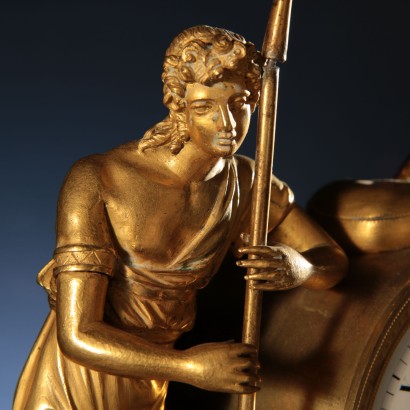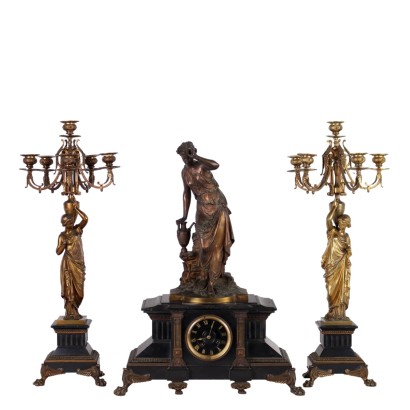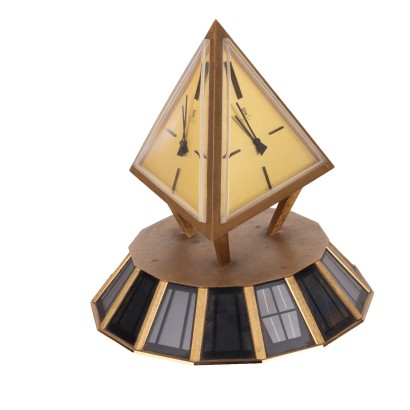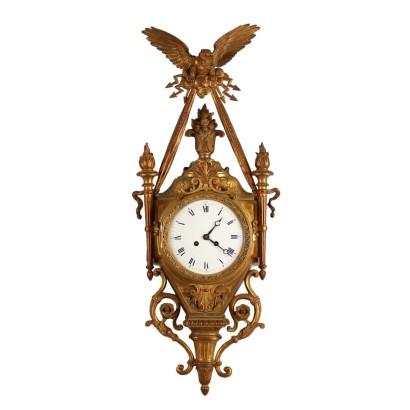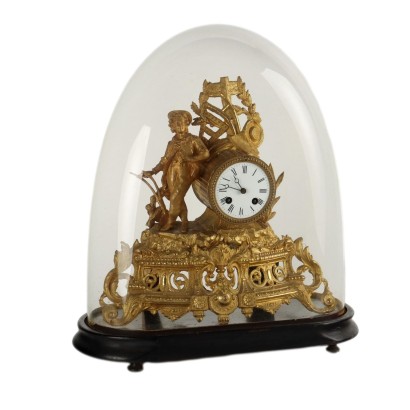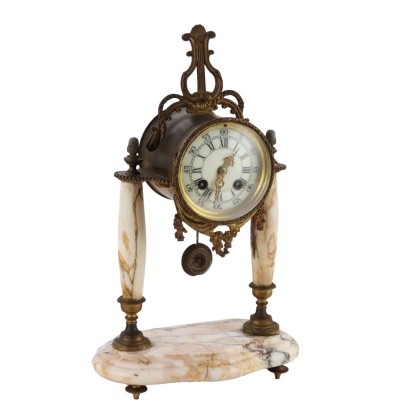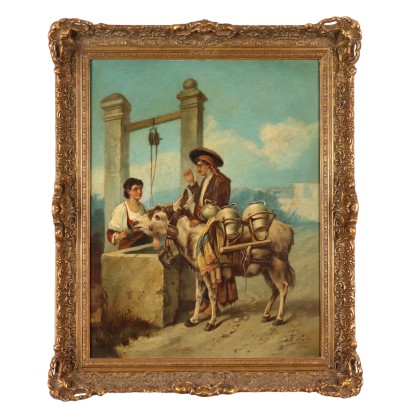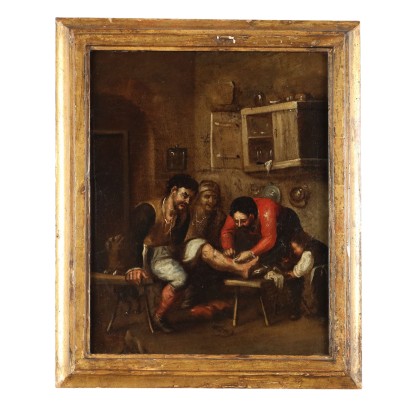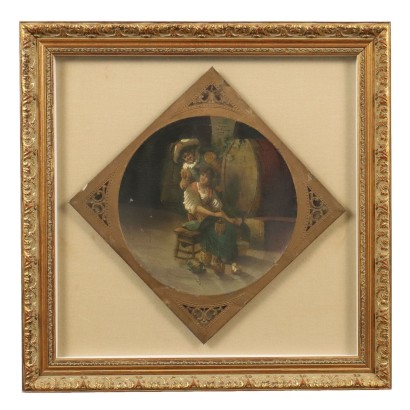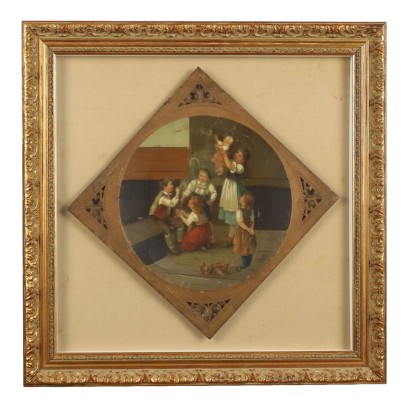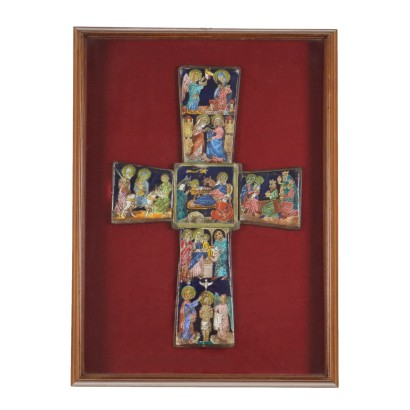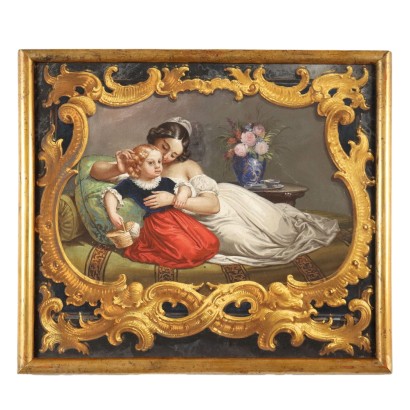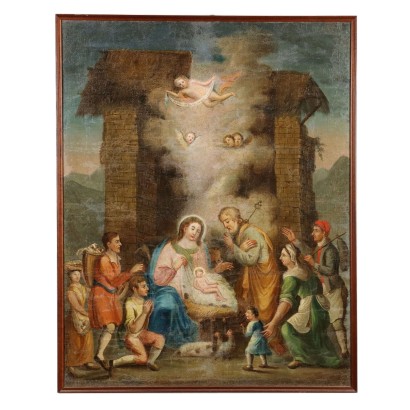Antique Mantel Clock Gilded Bronze Italy XIX Century - Camillo Borghese
Features
Camillo Borghese
Age: 19th Century / 1801 - 1900
Origin: Roma, Italy
Material: Gilded Bronze
Description
The gilt bronze mantel clock has a base decorated on the front with leafy phytomorphic motifs and a central floral element, and is supported by elaborate spinning top feet that streamline its shape. On the base rests a large plinth in which the dial is housed and on the side the figure of a young man leaning against the plinth. The display of the clock in Roman numerals for the hours and Arabic numerals for the minutes bears the writing at the top “Lu. Lacroix H.er. " and under the heading "De S. A. I. Lu Prince Camille, A Turin". Under the dial, in gilded and chiseled bronze, there is a panoply with a basket overflowing with fruit and vegetables, above which a shovel and a lituo are crossed and from which two rich vegetable garlands hang; on the side a mask with female features within a crown consisting of two cornucopias and laurel branches. To the left of the plinth there is a young man with a short cassock and a long shovel held in his hands, in a relaxed attitude and leaning with his left arm against the structure of the clock, above which a bagpipe is placed. The mechanism is original. to the wind. The quadripartite tops, always in striped walnut, have an almond-shaped reserve in the center with floral decorations that is started inside by two fans and a central rose window. The feet are in the shape of a truncated pyramid.
Product Condition:
Product in fair condition showing some signs of wear.
Dimensions (cm):
Height: 31,5
Width: 19,5
Depth: 9,5
Additional Information
Notes historical bibliographic
The clock was made by a certain, and no better identifiable, Louis Lacroix who signs himself in the exhibition, identifying himself as a watchmaker "De S. A. I. The Prince Camillo à Turin" ("Of His Imperial Highness the Prince Camillus in Turin"). The Camillus mentioned here is Camillo Borghese, husband of Paolina, the famous sister of Napoleon Bonaparte, since August 1804 (even if the civil ceremony was celebrated only in November of the same year, in respect of the widow's mourning of the bride). The dating of the clock is possible thanks to the inscription: certainly after 27 March 1805, the date on which Camillo was conferred the title of prince of the imperial family and most likely after 1808, when he settled in Turin with the office of Governor. general of the Transalpine Departments. Its realization certainly had to take place by 1814, when Prince Camillo Borghese broke off relations with the emperor following his abdication, it seems very unlikely that he would continue to be called with the noble titles acquired under his reign. This hypothesis is supported by relating it to a mantel clock belonging to the Luigi Mallé collection and dated around 1820, where the author signs himself simply as “Lacroix a Turin”. Close comparisons are also possible with other watches signed by the same watchmaker, the most stringent one is with a specimen of the Cavour Foundation, and today in the old home of the homonymous family in Santena, probably inherited from the Count of Cavour by his grandmother, a lady of the company of Paolina Bonaparte at the Turin court. Compared to ours, the Foundation clock has the signature shown on the similar exhibition, as well as narrow tangencies can be seen in the structure of the object: almost identical feet support a decorated base, which supports the dial on the right and a figure in all directions on the left. round. The comparison with this clock makes it possible to state that not only the mechanism of the movement was always made by Lacroix, but also the bronze worker is the same, as demonstrated by the executive and stylistic tangencies of the two characters, probably following a collaboration established between the two. Valeriani also points out two other watches bearing the same signature on the exhibition, kept at the Victoria and Albert Museum and the Metropolitan Museum of Art in New York. Another example belonging to the Luigi Mallé collection.Age: 19th Century / 1801 - 1900
19th Century / 1801 - 1900Material: Gilded Bronze
Other customers have searched:
Orologi, orologio dorato, orologio da camino, orologio da appoggio, orologio da tavolo, trittico, pendola, parigina..
Vuoi conoscere di più sugli orologi? Consulta i nostri articoli del blog e di FineArt che ne parlano:
Leggi di più
Le lancette degli orologi ci insegnano cos'è il traforo
Cartel Barat a Paris Orologio in bronzo dorato
Orologio Phippard Japanned Longcase, secondo quarto XVIII secolo Orologio a torre
Trittico con orologio e coppia di candelabri, Etienne Lenoir – Henry Dasson, Francia, seconda metà XIX secolo
Orologio Impero da appoggio
Orologio “Carro di Telemaco”
Orologio da mensola, Camillo Borghese, Torino, 1808 – 1814
Orologio a Vaso, Francia, Primo Quarto XIX Secolo
Orologio Impero a pendolo “Pegaso e Perseo” Lesieur à Paris, 1815 ca.
Leggi di più
Le lancette degli orologi ci insegnano cos'è il traforoCartel Barat a Paris Orologio in bronzo dorato
Orologio Phippard Japanned Longcase, secondo quarto XVIII secolo Orologio a torre
Trittico con orologio e coppia di candelabri, Etienne Lenoir – Henry Dasson, Francia, seconda metà XIX secolo
Orologio Impero da appoggio
Orologio “Carro di Telemaco”
Orologio da mensola, Camillo Borghese, Torino, 1808 – 1814
Orologio a Vaso, Francia, Primo Quarto XIX Secolo
Orologio Impero a pendolo “Pegaso e Perseo” Lesieur à Paris, 1815 ca.
Product availability
The product can be seen at Cambiago
Immediate availability
Ready for delivery within 2 working days from ordering the product.




